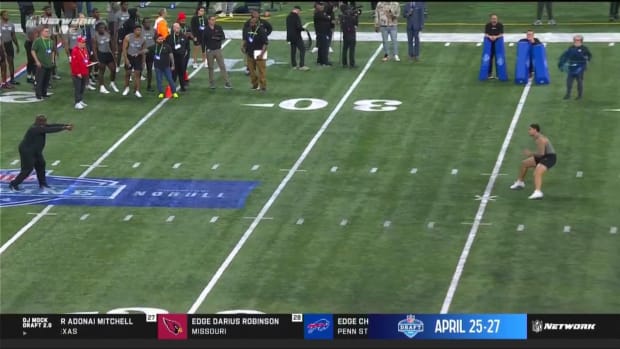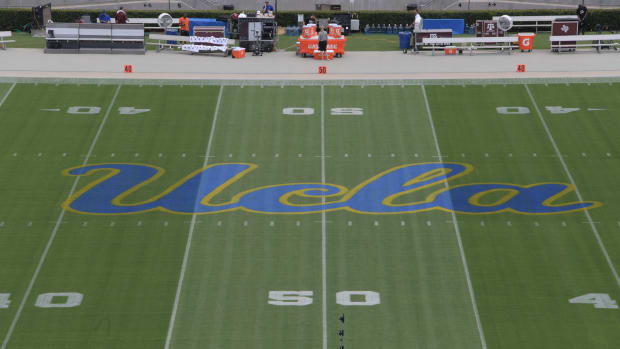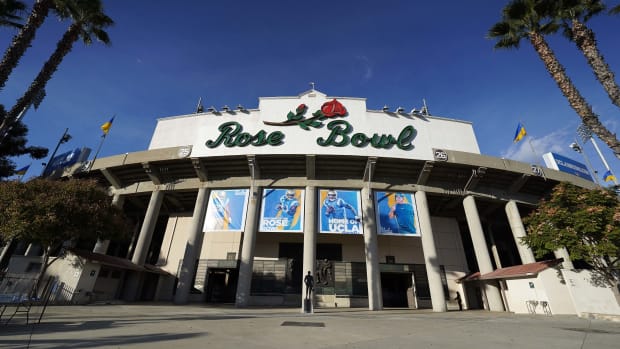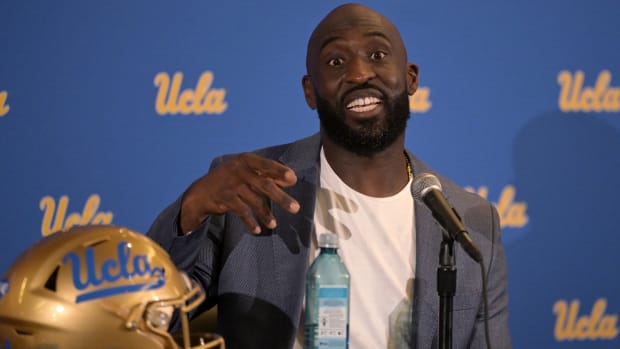UCLA vs. Washington Week 7: Scouting Report
As much as the Huskies' early losses seemed to have sunk their season, they haven't faded away just yet.
UCLA football (4-2, 2-1 Pac-12) will play Washington (2-3, 1-1) on Saturday night, having lost to the Huskies in each of their last two head-to-head matchups. This will be the first time the Bruins go up against head coach Jimmy Lake, who took over from Chris Petersen following the 2019 season, but he had been paying his dues on the Huskies' defensive staff for the previous six years.
Lake hired former Jacksonville Jaguars offensive assistant John Donovan prior to last season to be his offensive coordinator up in Seattle. Bob Gregory is in his first year as defensive coordinator, having formerly run the defense for Cal and Boise State over a decade ago, filling in for Petersen holdover Pete Kwiatkowski after he left for the Texas defensive coordinator job in the offseason.
So with last season and the first five games of 2021 in mind, here's a quick rundown of what Washington might look like come Saturday.
Washington Offense vs. UCLA Defense
Washington Passing Yards/Game: 258.6 yards
Washington Rushing Yards/Game: 147.2 yards
UCLA Passing Yards Allowed/Game: 307.8 yards
UCLA Rushing Yards Allowed/Game: 93.2 yards
Donovan has brought a seemingly simple, pro-style offense to Seattle, utilizing a pocket passer and leaning on specific targets throughout games. In the past, Donovan has favored the run, but throughout his career, he has been quick to adapt to personnel and is not married to one formation or scheme.
Running that offense is second-year quarterback Dylan Morris, who has seen basically all of his stats dip from his shortened debut season a year ago. Morris is completing just 58.9% of his passes for a 123.9 passer rating to go along with his seven touchdowns and six interceptions.
At 6-feet flat, Morris is not the most physically imposing guy, and it's not like he makes up for it with dual-threat ability either. He is almost exclusively a pocket passer, as he has -15 rushing yards to his name this season.
What Morris lacks in elite throw power and raw athleticism, he makes up for with his ability to read defenses and a lot of confidence in his arm.
While it isn't exactly a turnover-worthy play, it probably isn't the best idea for Morris to throw this ball. There's a man in tight coverage, but Morris sees that his wideout will have the best positioning after just one step to the inside. Maybe a better corner could have gotten a hand on it, sure, but Morris knew who he was going up against there.
Sometimes that aggressiveness can come back to bite him, though, and he sometimes doesn't give up on plays when he should.
Take this play against Oregon State, for example.
On 1st-and-10 in Beaver territory, it looks like he's going to go down for a 7-yard sack, but that's not the end of the world if you had two more downs to make up the yards and hopefully get into field goal range. Instead, Morris tries to throw through contact, and that throw goes way off course for an interception.
The UCLA pass rush has been hit-or-miss this year, only to came alive again late against Arizona last week. If they can rough up Morris, they may be able to force him into those goofy, play-extending overconfidence mistakes.
Once they get a little deeper downfield, though, Washington has been automatic.
The Huskies are one of four teams in the country with 100% red zone efficiency. On their 14 trips inside their opponents' 20, they have scored 10 touchdowns and hit four field goals. Donovan was credited with revamping the Jaguars' red zone offense back in 2016, and he called several games in which Jacksonville scored touchdowns on every trip they had inside the area.
While most of Washington's red zone touchdowns have come on the ground, Morris has been effective in the area as well. Donovan uses the short field and play action to try and get linebackers in coverage on receivers, like this second quarter play against Cal.
Starting the year with their top four receivers out, it's been a bit messy for the Huskies at receiver this fall.
Taj Davis, Terrell Bynym and Jalen McMillan all have between 15 and 20 receptions and 220 and 265 yards, so Morris has done a good job of spreading the ball around no matter who's available.
Tight end Cade Otton is back as well, fresh off an All-Pac-12 campaign in 2020. Otton's positive COVID-19 test kept him out of two games earlier this fall, limiting his gross stats to this point in the year. Still, Otton is immensely talented as an all-around tight end, and he could cause problems for the linebackers and strikers UCLA has to use in coverage.
Where the Bruins should have a little more success is getting to Morris before he gets the ball out of his hands.
The Washington offensive line was supposed to be one of the premiere units in the country, returning a ton of talent and size from a record-setting 2020. From left to right, there's Jaxson Kirkland, Julius Buelow, senior Luke Wattenburg, Henry Bainvalu and sophomore Victor Curne, all of whom are at least 6-foot-3 at 300 pounds.
That size and experience has not translated to success, however. After giving up two sacks all of last season, the Huskies' offensive line has already given up 12 so far in 2021.
Just look at how easily the pocket collapses when one pass rusher beats his man.
By the time Morris steps up to try and avoid the sack, the pocket loses all structure and only one of his five offensive linemen is still holding his own in a 1-on-1.
In the backfield, Richard Newton, Sean McGrew, Cameron Davis and Kamari Pleasant all have between 24 and 39 carries on the season. Injuries, benchings and other issues seem to have complicated the running back rotation to this point, although it seems like McGrew is the starting tailback after he rushed for 104 yards and two touchdowns in Washington's most recent game against Oregon State. Pleasant had 84 yards on 12 carries that game as well, so he stands to come in as a change of pace guy with his 6.2 yards per carry on the season.
As a team, Washington has only rushed for over 100 yards twice in five games this season, and the spotty offensive line has just as much to do with that than the
The Huskies have also passed more than they've run in all but one of their games this year, so for as inefficient as Morris has been, he's really been the focal point of their offense this year.
Quarterback-reliant offenses have obviously had success against the Bruins' secondary in 2021, with the unit allowing over 300 yards per game through the air. If UCLA can highlight Morris' weaknesses as keep him from having the best game of his season, an above average overall defensive performance is certainly on the table Saturday night.
Washington Defense vs. UCLA Offense
UCLA Passing Yards/Game: 209.0 yards
UCLA Rushing Yards/Game: 224.5 yards
Washington Passing Yards Allowed/Game: 116.6 yards
Washington Rushing Yards Allowed/Game: 179.6 yards
This is probably going to be the best secondary the Bruins have faced all year.
From zone to man to pure ball skills and athleticism, the Husky defensive backs check almost every box. Washington ranks No. 5 in the country allowing just 5.2 yards per attempt. That doesn't bode particularly well for quarterback Dorian Thompson-Robinson who has been inefficient overall but has been able to make up for it with explosive plays.
Thompson-Robinson's 57.1% completion percentage is the worst of his career, while his 9.8 adjusted yards per attempt his a career-high – the former ranks No. 9 in the Pac-12 and the latter ranks No. 1. With accuracy issues popping up here and there, Thompson-Robinson has been most effective when he can break off big plays, whether by taking the top off the defense in man coverage or by executing nice play designs by Kelly to get receiver Kyle Philips or tight end Greg Dulcich the ball in open space.
It really doesn't seem like he'll be able to do either against Washington on Saturday.
California's Chase Garbers is seemingly not the quarterback he once was, and even the UCLA secondary has shut him down over the past few years, but he is still a good enough Power Five starting quarterback. Even though Garbers put together a pretty solid performance overall a few weeks ago with 319 yards and a 73.2% completion percentage, the Washington defensive backs lured him into bad throws on multiple occasions.
Take a look at this play by cornerback Kyler Gordon, who was an All-Pac-12 honorable mention in 2020.
Gordon's ability to make up ground in man coverage and read the quarterback's eyes is dangerous, especially considering the tendency Thompson-Robinson has had in the past to get stuck on an early read and force the ball. Again, it hasn't been as much of an issue this year, but if his turnover-prone ways were ever to make a reappearance, Gordon would probably have something to do with it.
That first quarter interception wasn't even Gordon's best play of the day against the Golden Bears. Just look at what he does in a one-score game in the second half, again in man coverage.
Throwing at Gordon will be ill-advised, as his two interceptions lead the Huskies, as do his four passes defended.
Cornerback Trent McDuffle is also disruptive, just looking at his two interceptions, three forced fumbles and five passes defended in his 20-game career. Oklahoma transfer Brendan Radley-Hiles hasn't got an interception just yet – his one against Cal was called back on a penalty – but he has two passes defended and has even got into the backfield with 2.0 sacks on the season as well.
Safeties Cameron Williams and Alex Cook are in their fourth and fifth years at Washington, respecitvely, and are both respectable players in their own rights.
Throwing against these guys will be quite the tall task, and it may be one UCLA wants to avoid altogether given the fact that there's a decent chance of rain Saturday night, and that Washington's run defense has been so shaky to start the year.
The Huskies rank No. 93 in the country with 4.6 yards allowed per rush, but interestingly enough, that average isn't exactly being skewed upwards by a few big plays. Washington has only allowed two rushes of over 20 yards through five games, and yet teams continue to run it down their throats.
To this point, the errors in the Huskies' run defense has had more to do with getting out-muscled up front and not bringing a ton of help into the box to account for that. The second level does a fine enough job of tackling, but opposing ball-carriers often pick up 5 to 8 yards with ease before they arrive to snuff it out.
They're disciplined enough to prevent game-breaking mega runs, outside of this one from Michigan back in September.
Here, Williams makes the wrong read off the snap and isn't able to recover in time to close things up on the left side of the field. Hybrid defensive back Kamren Fabiculanan should have had a chance to minimize the damage, but he sank back and took the wrong angle once he realized how quickly running back Blake Corum had burst through the hole.
That won't happen very often, but clearly it is possible if you're offensive line can match up with the entire front seven and let the running back make a play. UCLA has done that early and often this year, starting in the Hawaii and LSU games, then bringing it back against Arizona.
The continuity and experience of Sean Rhyan, Paul Grattan, Duke Clemens, Jon Gaines, Atonio Mafi and Alec Anderson has worked well this year, and it should again against a Washington defensive line that has not done its job in stopping the run this year. Tuli Letuligasenoa and Sam Taimani are holding down the interior pretty well, but it's the ends and edge rushers who have faltered in run coverage.
For all of his success as a pass rusher, Ryan Bowman has not done well in stopping the run, and neither has freshman Cooper McDonald. Underclassmen Carson Bruener and Daniel Heimuli have not done very great as run-stopping inside linebackers despite their early playing time.
Linebackers Edefuan Ulofoshio and Jackson Sirmon have 41 and 38 tackles so far this year with a combined 3.5 tackles for loss, so they are really the only ones who have prevented things from really getting out of control on the ground.
Still, taking out its games against Montana and Arkansas State, Washington is allowing a whopping 241 rushing yards per game. When teams with Power Five-level offensive lines meet this Washington front seven, opposing coaches know exactly how to attack it.
Don't expect Kelly to be any different, as running the ball has been a recipe for success for his team so far this year. After putting up 329 rushing yards against Arizona a week ago, UCLA may be aiming for that figure yet again in Seattle.
Follow Connon on Twitter at @SamConnon
Follow All Bruins on Twitter at @SI_AllBruins
Like All Bruins on Facebook at @SI.AllBruins
Subscribe to All Bruins on YouTube
Read more UCLA stories: UCLA Bruins on Sports Illustrated
Read more UCLA football stories: UCLA Football on Sports Illustrated




